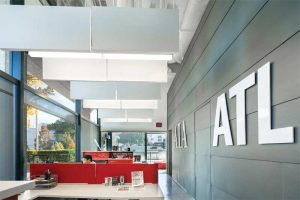
How to properly specify sound-absorbing objects
The absorption performance of sound-absorbing objects, such as baffles, banners, islands, and clouds (theatre seats, too) should be reported and specified using frequency-specific sabins of absorption per object. (Refer to ASTM C423, paragraph 12.1.4.) An example of a specification for the absorption performance of a 0.6- x 1.2-m x 51-mm (2- x 4-ft x 2-in.) thick acoustic stone wool baffle is provided below.
2.30 sound absorption (J mount)
Hz 125 250 500 1000 2000 4000
sabins 3.50 4.00 7.10 8.50 8.40 7.80
Some manufacturers do report the absorption performance of their sound-absorbing objects, such as baffles, in terms of NRC. This is incorrect and not a valid method of comparing their absorption performance to other products, or to the NRC or RT60 requirements in building standards, guidelines, or rating systems. They have obscured the useful absorption information about their products. Other manufacturers only report a single sabin number without any indication to which frequency band it applies. For example, if the reported absorption of a baffle is 6.0 sabins—a single number with no frequency information—how does one compare it to the proper specification shown above with sabins of absorption for each octave band? In the lower frequencies, the baffle designated as having 6.0 sabins of absorption outperforms the stone wool baffle above. Conversely, the stone wool baffle has better absorption performance in the upper four octave bands.
Intent of the standards
When a standard, guideline, or building rating system requires a minimum ceiling NRC—for example, NRC 0.90 in open offices—the intent is not to limit design options and force architects and specifiers to use standard, suspended, acoustic panel ceilings when they may not align with the desired aesthetics. The intent is to ensure there is enough sound absorption overhead, so students can understand their teachers, patients can sleep and recover more quickly, and workers can be productive, accurate, and comfortable. One option to comply with the intent of the standard is to use a suspended, acoustic stone wool ceiling panel with an NRC rating of 0.90 or higher. But the intent of the requirement in the standard can be met with numerous other design approaches, including vertically hung baffles and horizontally hung clouds or islands.
The proper approach to ensuring the intent of the standard is being met does not involve trying to get manufacturers who are correctly reporting the performance of their sound-absorbing objects in sabins to arbitrarily create an NRC rating for their products. Instead, the correct approach is to simply calculate how many sabins of absorption a ceiling with an NRC rating of 0.90 would provide and ensure the alternative sound-absorbing objects are providing at least the same amount of absorption. An example is provided below.
Requirement For maximum points, the WELL Building Standard requires a minimum ceiling NRC of 0.90 above open offices.
Option 1
Select and specify a high-performing, acoustic stone wool ceiling panel with an NRC rating of 0.90, 0.95, or higher.
Option 2
Calculate the sabins of absorption provided by the ceiling in Option 1. If the open office is 92.9 m2 (1000 sf), multiply the ceiling panel NRC of 0.90 by the floor area of 92.9 m2 to produce the 900 sabins of absorption provided by the high NRC ceiling. Next, find out how many sabins of absorption will be provided by each of the preferred acoustic baffles. One option is to average the sabins of absorption provided by the baffle at the 250, 500 1000, and 2000 Hz octave bands, which covers the same frequency range as does NRC. If each baffle, such as the 0.6- x 1.2-m x 51-mm (2- x 4-ft x 2-in.) thick acoustic stone wool baffle in the example above, provides 8.0 sabins of absorption (average of 250 to 2000 Hz octave bands), then 113 of those specific baffles would be required over the open office area to provide the equivalent amount of sound absorption as the NRC 0.90 ceiling, and to comply with the NRC requirement in the WELL Building Standard.




